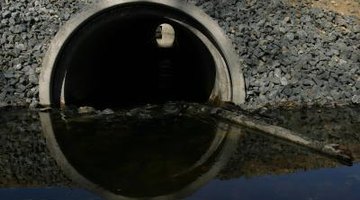DIY: Cast-In-Place Lining System
Age and extreme water pressure damage sewer pipes that eventually collapse. To avoid the costly repairs of digging out the damaged sewer pipes and installing new ones, contractors can install a cast-in-place pipe lining. CIPP lining involves an epoxy resin that adheres to the existing pipe and cures into a new pipe inside the old one. CIPP lining can be installed into pipes for both commercial and residential buildings, or for city storm sewers.

Step 1
Send the closed-circuit television camera system down into the pipe to inspect the line. Take measurements for the length of the pipe. Note the pipe's conditions, such as blockages or tree roots.
Step 2
Remove the CCTV system. Insert the water jet cleaning equipment to clean the pipe of small debris. Connect a root cutter to the water jet nozzle to saw through the invasive roots and wash the pipe clear of the cuttings.
Step 3
Take the cleaning equipment out of the pipe. Cut the CIPP sleeve to length based on the measurements obtained from the camera inspection. Base the size of the sleeve and thickness of the epoxy resin cure on the size and depth of the pipe.
For example, if you are placing a CIPP lining into an 18-inch pipe, the thickness of applied epoxy resin must be 0.41 inches if the pipe's depth is 14 feet. If the 18-inch pipe is 18-feet deep, you must apply 0.47 inches of resin lining.
Step 4
Apply the necessary thickness of CIPP epoxy resin to the lining sleeve. Insert the sleeve into the pipe until it is fully extended. Cure the lining against the pipe walls by circulating hot water through the line. Check the water gauges to ensure a constant temperature not exceeding 150 degrees F.
Step 5
Inspect the edges of the epoxy resin at the edge of the pipe entrance to check for hardness. Pump cold water into the line for the cool-down phase until the temperature is below 100 degrees F.
Step 6
Drain the water. Feed the CCTV camera into the pipe to inspect for an even curing along the pipe.
References
Tips
- For some applications, the contractor may use air pressure to cure the epoxy resin lining. Have the project properly inspected at every phase of the installation.
Writer Bio
Based in southwestern Pennsylvania, Michelle Hickman has written since 2006 on an array of topics including lifestyle, writing instruction and financial services. Her first articles appeared in "The Pittsburgh Tribune Review: Focus Magazine." She holds a certification in computer and information science from Central Westmoreland Career and Technology Center.
Photo Credits
- Jupiterimages/Photos.com/Getty Images
More Articles



